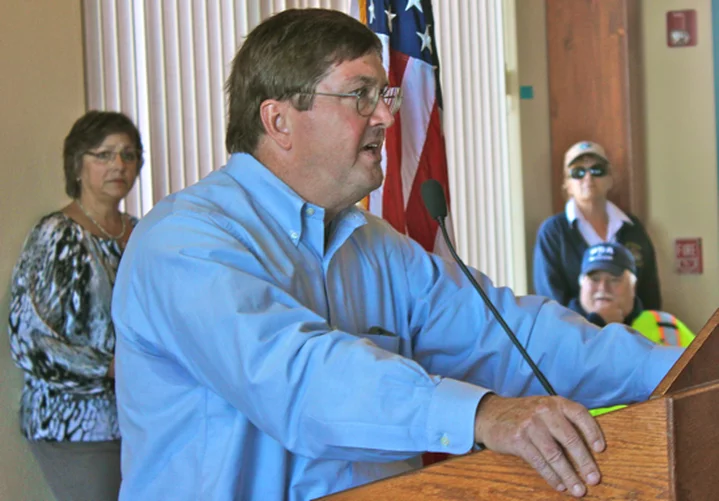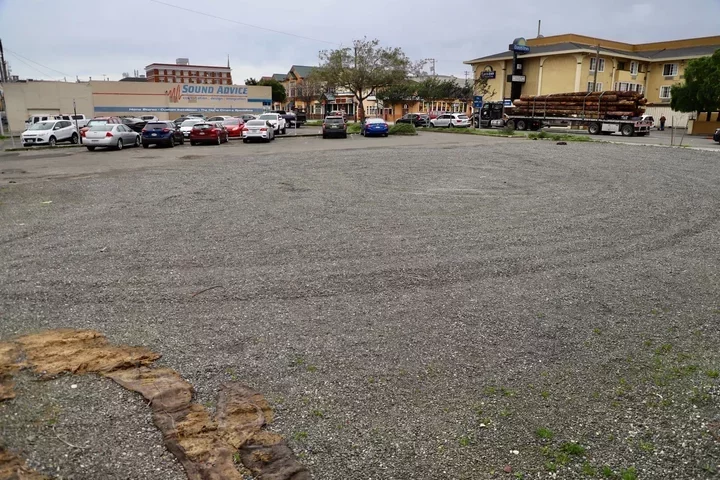OBITUARY: Dakota Rose Stafslien, 1996-2024
LoCO Staff / Tuesday, July 2, 2024 @ 6:56 a.m. / Obits
With much sadness, Dakota Rose Stafslien unexpectedly passed away at the young age of 28 in the early hours of May 4, 2024. She was born March 19, 1996 in Garberville, but grew up in Shelter Cove. Dakota attended Whale Gulch School, Redway Elementary and South Fork High School.
Dakota had many passions. She was certified in massage and over the past year she attended many classes at College of the Redwoods, including Fire Academy, which she had just graduated and was getting ready to start a career in with friends she made along the way. Dakota recently took a trip sailing to the Bahamas with friends she met online and told us all about the pigs that live on the beaches there. It was a great adventure !
Dakota loved art! All art! She always kept herself busy with a range of hobbies that included art (of course), music, beading, sewing, kayaking, road trips and learning all she could from making kombucha to documentaries that she would put online. Dakota’s ray of sunshine will be sorely missed by everyone who loved her, including her best friend Weston Cole Field who was always there for her. They shared many adventures together, and Arianna Guillette, whom she grew up with, was always by her side.
She is survived by her mother, Sandra Brown (Ferndale); father, Samuel Stafslien (Shelter Cove); sister Jasmine (Torrey) Hass and their three children, Olivia, Oliver and Felix Hass (Garberville); and half-sister Sammy Stafslien (Whitethorn); grandfather Bruce Winter (Mountain View, Arkansas ); and second grandmother Kathy Brown (Fort Bragg).
Dakota is preceded in death on her mother’s side by her second father, Wade Brown (Miranda); and grandmother Kathy Winter (Mountain View, Arkansas); and second grandfather Whitey Brown (Fort Bragg). On her father’s side both grandparents Tim and Barbara Stafslien ( Southern Humboldt area).
I would also like to thank everyone who lent Dakota a helping hand over the years whenever she needed it.
###
The obituary above was submitted on behalf of Dakota Rose Stafslien’s loved ones. The Lost Coast Outpost runs obituaries of Humboldt County residents at no charge. See guidelines here.
BOOKED
Today: 3 felonies, 12 misdemeanors, 0 infractions
JUDGED
Humboldt County Superior Court Calendar: Today
CHP REPORTS
7841 Mm101 N Men 78.40 (HM office): Animal Hazard
ELSEWHERE
RHBB: Reports of Multi-Vehicle Collision at 5th and V Cause Traffic Delays in Eureka
RHBB: Yurt Fire Reported East of Willow Creek on Thanksgiving Morning
KINS’s Talk Shop: Talkshop November 27th, 2025 – Jason Esselman
Governor’s Office: Governor Newsom proclaims Thanksgiving Day
OBITUARY: Gerald Drucker, 1952-2024
LoCO Staff / Tuesday, July 2, 2024 @ 6:56 a.m. / Obits
Gerald Drucker passed away peacefully at home under Hospice care
surrounded by his family on April 4, 2024. He was born May 26, 1952
in New York, N.Y. to Estelle (Stahl) and George Drucker and spent his
youth growing up and going to school in the New York area.
Jerry spent his childhood and teen summers on Ocean Beach, Fire Island where he formed enduring friendships with family and friends. He was a member of the lifeguard team and developed his love of and skill in surfing. After graduating from Fieldstone High School he followed his surfing dream to the Southern California coast and attended UC Irvine. He left college after a year and moved on to the beaches of Mexico to focus his studies on surfing. He returned to academics and graduated from Bard College in psychology before moving to Santa Barbara to continue his studies. During his time at UCSB he balanced his academics with more surfing and met his to-be spouse, Lynda McDevitt. He graduated in 1983 with a Ph.D in psychology and a minor in surfing.
Jerry moved to Regina, Sask., Canada to be employed at the Merici Center, an early childhood intervention center. There he and Lynda were married and shortly after had their first son, Michael. This was a time of professional growth, devotion to his new family, the development of long-time friends and, as any ocean was over a thousand miles away, an enthusiasm for cross-country skiing.
After four years in Canada the call of the Pacific Ocean and family led to a return to California. Jerry, Lynda and Michael made their home in Westhaven and in 1992 added their son, Jesse, to the family. There Jerry expanded his sports enthusiasm to include mountain biking, downhill skiing and backpacking. Through these activities he developed strong friendships and offered fabulous adventures to his family.
Jerry was employed at the Redwood Coast Regional Center, which provides services for clients with developmental disabilities and their families. Jerry stayed at the RCRC for 34 years. He also worked a day per week at Hoopa Valley Tribe, Division of Human Services for 17 years and also had a private practice in Eureka. In each of these settings he was known to provide caring advocacy and compassionate counsel to his many clients and established warm bonds with his colleagues in the centers he worked at.
Jerry suffered a series of strokes in 2019, which preceded the final stroke in March 2024. His capabilities as an excellent athlete and brilliant mind were diminished over these years but the playfulness, interest in sports, humor, and generosity were never diminished. He will be remembered as a warmhearted being who loved life to the fullest.
Jerry is survived by his wife of 40 years, Lynda McDevitt; his sons, Michael and Jesse Drucker, their respective partners, Ivonne Romero and Madeline Cooper; his nieces, Sarah Dowling, Jessica Houlder and Devon Marvel; his brothers-in-law and sister-in-law, Ray and Mary McDevitt and Ben Dowling; and numerous grand-nephews and nieces and cousins. He was preceded in death by his parents, Estelle and George Drucker; his sister, Lauri Dowling; and cousin Risa Krive.
A memorial will be held at the Unitarian Universalist Fellowship in Arcata on August 3 from 1-4 p.m.
###
The obituary above was submitted on behalf of Gerald Drucker’s loved ones. The Lost Coast Outpost runs obituaries of Humboldt County residents at no charge. See guidelines here.
OBITUARY: Antoinette ‘Toni’ Moody-Holland, 1972-2024
LoCO Staff / Tuesday, July 2, 2024 @ 6:56 a.m. / Obits
Antoinette “Toni” Moody-Holland
August 5, 1972 - April 3, 2024
Antoinette “Toni” Moody-Holland passed away unexpectedly on Wednesday April 3, 1972. Born on August 5, 1972 to Butch Moody and Joan Burke in Garberville.
In the early ‘90s she met Brian Anderson. Her and Brian welcomed their first and only child together, Allen, in 1994. Toni went on to meet her first husband, James Holland. James and Toni had their first child in 1997 — Katie. James, Toni and their kids lived in Fortuna for awhile before James’ job moved them to Scotia. Toni was a stay-at-home mom, while Katie was young. Toni loved to be involved with her kids’ classroom activities, going on field trips, volunteering for field day chaperone, and just getting to hang out with her kids.
In 2004, James and Toni separated, and Toni moved across the river to be closer to her job. While living in Rio Dell, Toni worked at E&J Liquors as the baker/deli manager. Her daughter Katie has fond memories of being the one to make the design with a fork on their peanut butter cookies while “working” alongside her.
In 2004, after her separation with James, she met Ryan Moon. Who she moved to Loleta with. In 2006, they welcomed a baby girl, Tasheena.
Toni loved her kids with so much of her being, having three beautiful children is something she would brag about to anyone she talked too. If you’ve ever had a conversation with Toni, it’s certain you heard about her kids.
Toni loved rocks, collecting trinkets, doing arts & crafts, writing poems, frogs; all the little things. Toni really just had a love for the important to her things in life.
Toni is preceded in death by her mom, Joan; her dad and step-mom, Butch and Jan Moody; and her sister Buffy.
Toni left behind her three children, Allen Holland, Katie Holland (Karl Delara) and Tasheena Moon; her basically adopted son Angel; her long time boyfriend Ryan Moon; her sisters Tina Moody (Byron Titus), Deena Yadon and Starla Moody; her two best friends Eva and Melene; and so many nieces and nephews; all of who knew how much they meant to her.
She loved her family more than anything and we will miss her for the rest of our lives.
###
The obituary above was submitted on behalf of Toni Moody-Holland loved ones. The Lost Coast Outpost runs obituaries of Humboldt County residents at no charge. See guidelines here.
OBITUARY: Robert Vernon Ford, 1931-2024
LoCO Staff / Tuesday, July 2, 2024 @ 6:56 a.m. / Obits
On May 2nd, 2024, Robert Vernon Ford, known affectionately as “Bob” and “Uncle Bob,” peacefully passed away at his home at Silvercrest in Eureka. He was 92 years old, born on November 3rd, 1931, in Willits.
Bob’s life was marked by his deep passion for fishing, a hobby he cherished throughout his years. Many Saturdays were spent with his fishing buddy, Gerald. When they weren’t fishing together, they would attend local events, creating cherished memories. Bob always had great stories about those Saturday adventures. Many times, “Uncle Bob” would spend time with his family over at Coffee Creek in Trinity County, where he would eagerly wait for someone in the family to be headed to the nearby fishing pond.
Beyond fishing, Bob had a lifelong love for flying, having served in the air force during the Korean War and later piloting a crop duster over the fields of Idaho. His commitment to community was evident through his twenty-year membership at the Humboldt Senior Resource Center, where he participated in their day program.
Throughout his later years, Bob formed close bonds with his caretakers Denise, Rachel, and Matt, who became like family to him, sharing holidays and special moments together. He was preceded in death by Linda Botsford, a cherished caregiver who held a special place in Bob’s heart.
Bob will be fondly remembered for his infectious sense of humor, his penchant for dressing up in holiday costumes, and his unwavering zest for life. He approached each day with generosity, kindness, and a deep appreciation for the joys life offered him. His warm smile and easy-going nature endeared him to all who knew him.
Bob is survived by his brother Wayne Ford, step-sister Janice Campbell, cousins Glenn Ford, Gary (Diane) Ford, and Delman (Donna) Ford, numerous second cousins, several great nieces and nephews, as well as numerous extended family throughout Humboldt and Mendocino Counties, alongside many close friends.
A Celebration of Life honoring Bob will be held on Saturday, July 27, 2024, at 2 p.m. at the Humboldt Bay Social Club, suitingly in “The Hangar,” located at 900 New Navy Base Rd. in Samoa.
###
The obituary above was submitted on behalf of Bob Ford’s loved ones. The Lost Coast Outpost runs obituaries of Humboldt County residents at no charge. See guidelines here.
Rob Arkley Pursued Purchase of Jacobs Middle School Property Before Eureka City Schools Entered Land-Swap Deal With Secretive Corporation
Ryan Burns / Monday, July 1, 2024 @ 2:42 p.m. / Housing , Local Government
Rob Arkley in 2014. | File photo by Andrew Goff.
###
Security National founder and political lightning rod Rob Arkley was in discussions with Eureka City Schools about purchasing the vacant Jacobs Middle School campus before the district entered into a surprise land exchange agreement with a mysterious corporation called AMG Communities - Jacobs, LLC, which had been created just two days earlier.
“Prior to AMG’s successful bid for the property, Security National Properties communicated with the District as a potential buyer and also provided guidance regarding buying, selling, and managing properties,” Security National spokesperson Gail Rymer told the Outpost via email. “However … Security National Properties is not a buyer of the Jacobs property and is not involved with AMG Communities, nor is Rob Arkley.”
The revelation of Arkley’s involvement in negotiations with the district comes after the Outpost reviewed heavily redacted copies of the district’s communications in the months leading up to its board of trustees’ unexpected and controversial Dec. 14 decision to enter the land swap deal with AMG.
The 246 pages of documents turned over to the Outpost reveal that administrators and attorneys for Eureka City Schools exchanged dozens upon dozens of emails hammering out details of the agreement with AMG ahead of that December board meeting.
This runs contrary to what the district told the North Coast Journal back in March via attorney Harold Freiman of the Walnut Creek firm Lozano Smith. Freiman said a search for documents did not locate any correspondence to or from former Superintendent Fred Van Vleck that referenced a property exchange for the Jacobs site, AMG Communities-Jacobs LLC or any of its representatives — with a single exception.
As reported by the Journal’s Thadeus Greenson, the district’s records search found only this:
a text message to Van Vleck from school board President Susan Johnson, sent about 50 minutes before the board went into closed session on Dec. 14 to discuss the proposed property exchange for the first time, with a Lost Coast Outpost headline referring to the “mystery item” on that evening’s agenda. Van Vleck did not respond, according to the documents released to the Journal.
Asked to clarify, Freiman said no documents were found and withheld after being determined to be exempt from disclosure under public records law.
“Based on the document trail provided by the district, it’s as if the deal materialized out of thin air,” Greenson wrote.
Now we know that’s far from the truth. The Outpost submitted its own California Public Records Act request after reading the recent Humboldt County Civil Grand Jury report criticizing the district for its lack of transparency and for the Board of Trustees’ lack of due diligence before “rubber stamp[ing]” the deal.
The Grand Jury report notes that Bradley B. Johnson, a San Diego-based attorney who represents Security National and several other Arkley-affiliated organizations (as you’ll read more about below), “sent and received many emails [emphasis added] to and from ECS administrative staff and legal counsel regarding the Jacobs property real-estate transaction before and after the December 14, 2023, ECS trustee meeting.”
Those emails delve into such matters as parcel surveys, deeds, inspections, escrow, lease terms, revisions to contract language and more, though many of the details are hidden behind redactions.
Why weren’t those emails disclosed to the Journal?
Arielle Percival, another Lozano Smith attorney representing the district, offered the Outpost this explanation:
In Mr. Freiman’s conversation with Mr. Greenson, he indicated that he knew of no other communications responsive to Mr. Greenson’s request beyond materials that had been redacted or withheld for privilege, and that no other responsive materials had been located in Mr. Van Vleck’s emails. … [T]he Grand Jury invoked its subpoena power and gave assurances of confidentiality that led to some of the communications from and to my office later being provided to the Grand Jury, though those communications as provided still included redactions intended to continue to preserve the attorney-client privilege.
Whether or not that’s sufficient legal justification for denying the release of such communications in response to a Public Records Act request, the fact remains that Eureka City Schools was in regular contact with Security National’s go-to attorney, Johnson, in the weeks and months leading up to the Dec. 14 board meeting.
The California Highway Patrol had spent more than four years negotiating with the district to purchase the Jacobs property for $4 million. The agency was hoping to build its new Northern Humboldt headquarters there, relocating from Samoa Boulevard in Arcata to get out of the tsunami zone. The CHP had outbid the City of Eureka, which offered $2,818,000 for the property but bowed out when the asking price got too steep.
CHP personnel were reportedly caught off guard when the Eureka City Schools Board of Trustees voted unanimously to take another route altogether, one that had been kept almost entirely secret from the public until just 90 minutes before the board’s decision.
Following a closed session hearing with Van Vleck, who was attending his final meeting before retiring from the district, the board opted to trade the Jacobs property to AMG Communities - Jacobs, LLC, which had been created just 48 hours earlier. In exchange, the district is slated to receive a two-unit residential property on ⅛ of an acre on I Street, plus $5.35 million in cash.
The AMG offer is valued at $6 million, a full $2 million more than the CHP bid and more than twice what the City of Eureka was willing to pay.
The property at 3553 I Street contains two separate units. In an email to an attorney, Assistant Superintendent Paul Ziegler observed that the property “looked dated.” | Image via Eureka City Schools.
The transaction hinged on a clever use of the California Surplus Land Act, which allows government agencies to exchange “surplus property” with other parties while sidestepping a lot of red tape. In this case, the maneuver allowed Eureka City Schools to avoid a number of California Education Code requirements that are part of standard real estate deals with school districts. Thanks to the inclusion of the small residential property at 3553 I Street, which the district says it will use to house employees, this deal qualifies as a trade, even though the vast majority of the offer’s value comes via the millions in cash.
The documents provided to the Outpost show district administrators rushing to complete the deal before the end of the year while being careful not to release any information about it to the public until the last minute.
They also reveal that Johnson and the district initially had an altogether different property lined up for the land swap, a four-plex at 4242 Walnut Drive in Cutten. But on Nov. 28, barely two weeks before the board’s decision, Johnson informed the district that the seller of that property had backed out. Not to worry, though; Johnson had quickly lined up “an entirely different property for the exchange,” as Freiman later reported to Van Vleck and Assistant Superintendent Paul Ziegler.
Van Vleck (left) and Ziegler at a 2022 Eureka City Schools Board of Trustees meeting. | File photo by Andrew Goff.
###
On the morning of Dec. 12, just two days before the school board meeting, Freiman asked Johnson via email whether AMG actually existed.
“Not yet,” Johnson replied. “We are forming it today on the 24-hour turnaround.”
In its report published two weeks ago, the Grand Jury concluded that, prior to hastily agreeing to a $6 million property deal with such a newly created entity, “ECS Trustees did not publicly verify the bona fide identity and finances of AMG Communities-Jacobs, LLC.” The report also found that “Prior public notice failed to personally name the AMG Communities-Jacobs, LLC principal members or negotiator(s).”
To date, AMG has only provided the district with a $100,000 deposit. The deal remains in escrow, with a target closing date of July 11. More than six months after the exchange was arranged, the interests behind AMG Communities - Jacobs, LLC, remain a closely held corporate secret.
While AMG established a website (which currently features an aerial shot of the San Francisco Bay Area on its homepage, for some reason) and an email address where you can send inquiries, the people who respond to those inquiries have steadfastly refused to identify themselves or anyone else involved with the company, except to say in the website’s FAQ section, “Rob Arkley is not an owner or investor in AMG Communities.”
Even if that’s true — and currently we have only their word for it, and Arkley’s — there is ample connective tissue linking Arkley and Security National to a range of initiatives aimed at moving affordable housing development plans away from Eureka’s downtown and over onto the Jacobs property, which sits at the southern border of city limits.
The City of Eureka’s current development plans involve converting several municipal parking lots into apartment buildings to help satisfy state mandates for affordable housing.
Arkley has railed against these efforts for years, saying the developments would eradicate too many parking spaces. In angry exchanges with Eureka City Manager Miles Slattery and other staffers, Arkley has said the parking lots in question are “critical for safety” and “the lifeblood of downtown retail and restaurants.”
In late 2022, Arkley threatened to move Security National headquarters out of Eureka — a threat he has yet to follow through on. In a 2021 interview on KINS Radio’s “Talk Shop” he vowed to take legal and political action — namely lawsuits and a ballot initiative — aimed at thwarting the city’s plans.
Through Security National, he has done just that. Citizens for a Better Eureka, a nonprofit corporation financed by the company, filed a series of five lawsuits last year intended to halt affordable housing developments on four city-owned lots.
Security National is also footing the bill for the “Eureka Housing for All and Downtown Vitality” initiative, which will appear on the ballot in November. If passed, the measure will create new restrictions on 21 city-owned parking lots around town. Any housing developments on those lots would be required preserve the existing number of parking places and add new ones to accommodate residents, should they be deemed necessary.
Those requirements — which would be enshrined via an amendment to the city’s general plan creating an “Off-Street Public Parking (OSPP) Overlay Designation” — could render most of the city’s current affordable housing development plans infeasible. That includes the Linc Housing projects at Eighth and G and Sixth and M streets, which have received tens of millions of dollars in grant funding.
The parking lot at the corner of 5th and D streets (in the background) beyond the gravel lot where the Lloyd Building once stood. | File photo by Andrew Goff.
###
It should be pointed out that the measure includes an escape clause, of sorts, for one of those 21 municipal parking lots: the one at the corner of 5th and D streets. That’s the lot half a block from Security National’s 5th Street headquarters, and in recent years Arkley and his staff unsuccessfully tried to negotiate a number of deals to acquire it.
Currently, the Wiyot Tribe’s Dishgamu Humboldt Community Land Trust plans to build a multi-income housing development there, along with another high-density housing project a few blocks away, at 6th and L. The “Housing for All” initiative says those projects will be exempt from the measure’s parking requirements, but only if the Wiyot agency remains the bid awardee and developer.
If the Wiyot project falls through for any reason and the city decides to trade the 5th and D lot for another parcel, then the parking overlay “shall cease to apply,” the measure says, in which case the parcel could be developed with a wide range of commercial uses, including bars, retail, restaurants, car sales and more.
Meanwhile, glossy mailers paid for by Security National invite the public to “imagine what’s possible” at the Jacobs site. The “Housing for All” measure would enable that property to be rezoned to allow for high-density housing development, though critics, including Eureka City Councilmember Kati Moulton, have noted that the measure wouldn’t actually commit AMG or anyone else to developing even a single house. The zoning changes could instead open the door to strip malls, car lots, bars and numerous other types of commercial development.
Whoever is behind AMG Communities - Jacobs, LLC, they’re working symbiotically with Security National on Arkley’s plans for Eureka, spreading the same message as “Citizens for a Better Eureka” and the “Housing for All” initiative. According to AMG’s website, the corporation was formed “solely for the purpose of acquiring the former Jacobs Middle School site … and exploring ways to develop the site in the future.”
As pointed out by the Journal and, more recently, by the Humboldt County Civil Grand Jury, there’s one attorney handling who’s been handling all of this interrelated business: Bradley B. Johnson.
From the Grand Jury report:
- Bradley B. Johnson reportedly initiated contact with [Eureka City Schools] in August 2023 suggesting another purchaser for the Jacobs property (besides the City or … CHP) using the land exchange provision of the California Education Code.
- Bradley B. Johnson is listed as the Secretary and Chief Financial Officer of Citizens for a Better Eureka in the Statement of Information for the nonprofit corporation filed with the California Secretary of State in September 2023.
- Bradley B. Johnson, representing Citizens for a Better Eureka, funded by Security National, initiated five lawsuits against the City of Eureka.
- Bradley B. Johnson signed the Agreement for the sale of the Jacobs property to AMG Communities-Jacobs, LLC as an agent for AMG.
- Bradley B. Johnson’s company, Everview Ltd., is listed in escrow documents as the purchaser of the 3553 I Street property.
- Bradley B. Johnson is listed as the Manager of AMG Communities-Jacobs, LLC in the Statement of Information for the LLC filed with the California Secretary of State in April 2024.
- Bradley B. Johnson sent and received many emails to and from ECS administrative staff and legal counsel regarding the Jacobs property real-estate transaction before and after the December 14, 2023, ECS Trustee meeting.
You can now read many of those emails for yourself, albeit in heavily redacted form, by clicking the link below.
###
DOCUMENT: Redacted emails and documentation from Eureka City Schools
The Jacobs campus. | File photo by Andrew Goff.
PREVIOUSLY
- Who Will Get the Former Jacobs Campus? Bidders for Blighted Site in Highland Park Are the City of Eureka and the California Highway Patrol, With a Decision Coming Soon
- The CHP Would Like to Build New Headquarters on the Property Championed by People Opposing Downtown Housing Development, and There Was a Meeting About it Yesterday
- Open Letter Urging Eureka Voters Not to Sign the ‘Housing For All’ Petition Endorsed by 100+ Humboldt County Residents, Including Local Leaders in Politics, Business and Culture
- New Coalition — ‘I Like Eureka Housing!’ — Formed to Oppose Arkley-Backed Pro-Parking Lot Initiative
- Mystery Item on Tonight’s Eureka City School Agenda Suggests Imminent Action on Jacobs Campus, but the School District Won’t Share Details
- Eureka City Schools Board of Trustees Unanimously Votes for So-Called ‘Land Exchange’ With Mystery Developer
- The Eureka City Schools Board Voted on a Resolution Last Week That Was Not Published Before the Meeting. Is That Legal?
- At Town Hall Meeting, Frustrated Residents Discuss Future Development of Eureka’s Jacobs Campus; Mystery Developer Still Mysterious
- Security National Has Spent at Least $236,000 on the Pro-Parking ‘Housing for All’ Initiative So Far
- Grand Jury Slams Eureka City Schools For ‘Secretive’ Jacobs Campus Deal
- League of Women Voters Chimes in on Lack of Transparency in Eureka City Schools Property Transfer
Fortuna Police Arrest Wanted Chop-Shop Suspect After High Speed Chase Sunday
LoCO Staff / Monday, July 1, 2024 @ 2:14 p.m. / Crime
PREVIOUSLY:
###
Press release from the Fortuna Police Department:
On Sunday, June 30th 2024, at about 4:30 p.m., Fortuna Police Officers successfully apprehended Daniel Fidler, a suspect wanted for numerous felonies, after a high-speed chase that began near Fortuna and concluded off of Hwy 36 near Carlotta, California.
The pursuit initiated on Rohnerville Road after an officer observed Fidler driving his red BMW. Despite officer’s attempts to conduct an enforcement stop, Fidler accelerated, prompting the high-speed chase. Fidler evaded police with willful and wanton disregard for the safety of people or property. The pursuit went through Fortuna and Hydesville and ultimately ended on the river bar near Carlotta.
During the chase, Fidler’s vehicle reached speeds on the highway exceeding 90 mph. Fortuna PD officers deployed spike strips, successfully disabling one of Fidler’s tires which eventually disabled the BMW. Fidler drove his vehicle into the river and fled on foot.
Fidler was apprehended quickly and without further incident. Officers on scene reported a safe and successful conclusion to the pursuit.
Fidler was booked into the Humboldt County Jail for nine (9) felonies involving vehicle theft related crimes, weapon related crimes, and reckless evading. He was additionally booked on a felony warrant for kidnapping and an 836 PC Want for Reckless Evading out of the Humboldt County Sheriff’s Office.
The Fortuna Police Department commends the involved officers for their professionalism and dedication in safely apprehending a dangerous suspect. We also extend our gratitude to the community for their support and vigilance.
For further information, please contact Chief Casey Day at (707) 725-7550.
The Hiker Who was Found Injured on the Lost Coast Trail Last Week is Recovering and Thankful for His Rescuers
Jacquelyn Opalach / Monday, July 1, 2024 @ 1:24 p.m. / Emergencies
The view of sunset from the Lost Coast Trail on June 24. Screenshot of a video by Sashank Upadhyayula.
###
PREVIOUSLY:
###
Almost a week after being discovered with severe injuries and memory loss along the Lost Coast Trail, Sashank Upadhyayula is still trying to piece together what happened to him.
Upadhyayula, a 34-year-old first-time backpacker from San Jose, was found hypothermic and covered in blood by a group of six teens and two camp counselors on the morning of June 25th. The two adults dressed some of his wounds and called for helicopter rescue by satellite phone, and Upadhyayula was taken to a hospital and released the same day.
Upadhyayula told the Outpost in an email that he has wounds on his arms, torso and throat, and shared what he can remember of the moments before and after he was injured.
Around 10 p.m. on Monday, June 24, “I remember hearing something, being scared and removing my bear spray, my two knives, water reservoir and my electronics,” Upadhyayula said. Next he can recall, Upadhyayula woke up in the surf. “[I] made my way to the trail and collapsed after getting my mylar blanket. I covered my torso with the blanket and assumed fetal position to retain heat.”
He was found around 9 a.m. the next morning.
“The doctors believe that it was a knife [or] bladed weapon,” Upadhyayula said. “With my lack of memory and because my knives are missing and how I was separated from my pack and found quite a distance away […] it all points towards me being attacked.”
Upadhyayula reported the incident to the Humboldt County Sheriff’s Office and to the Bureau of Land Management (BLM) King Range National Conservation Area Office.
BLM King Range Area Manager Paul Sever told the Outpost that the Sheriff’s Office has opened an investigation. But at this time, there is “no reason to believe that there is any threat to public health or safety” along the Lost Coast Trail, Sever said.
The Sheriff’s Office didn’t respond to requests for comment. We’ll update if more information becomes available.
[CORRECTION: The Sheriff’s Office had, in fact, sent us this response, which slipped through our inbox this morning. Apologies.]
The HCSO is continuing to investigate this incident but there is currently no information to suggest there is any current/on-going threat to safety of the public along the Lost Coast Trail. As with any such remote/rural area, we encourage people to make sure they are adequately prepared for the rugged terrain of that area (adequate food, clothing, maps, GPS enabled location/emergency notification device) and as with anywhere, people should always be aware of their surroundings and report any suspicious activity/behavior to law enforcement.
“I just want to thank the people that helped rescue me and I want the other hikers in that area just to be aware of their surroundings and to make sure that nothing like this happens ever again,” Upadhyayula said.
To his rescuers, Upadhyayula added: “Thank you from the bottom of my heart. I cannot express my gratitude, you are doing God’s work. I hope you achieve your dreams. Happy trails!”













